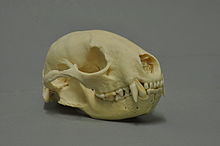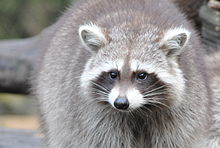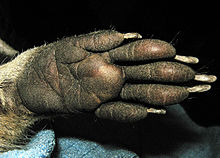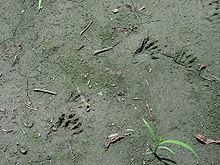Raccoon
![]()
This article is about the animal species raccoon, for the related genus see raccoons.
The raccoon (Procyon lotor), also known as the North American raccoon, once also known as the scaled raccoon, is a medium-sized mammal native to North America. Since the mid-20th century, it has also been present as a neozoon in mainland Europe, the Caucasus, and Japan, after escaping from enclosures there or being released. Raccoons are predominantly nocturnal predators and prefer to live in water-rich deciduous and mixed forests. Due to their adaptability, they increasingly live in mountain forests, salt marshes and urban areas.
With a body length between 41 and 71 centimetres and a weight between 3.6 and 9.0 kilograms, the raccoon is the largest representative of the small bear family. Typical for the raccoon are the distinctive haptic perception of the front paws and the black face mask. Furthermore, the good memory of the animals should be emphasized. In experiments, they were able to remember the solution of an earlier task even after three years. Raccoons are omnivores and eat about 40 percent plant food, 33 percent mollusks and 27 percent vertebrates. Raccoons kept in captivity often submerge their food under water, which has been interpreted as "washing," but is most likely an idle act to imitate foraging on river or lake shores, where the raccoon, groping under rocks and other hiding places, searches for crayfish or other food.
While the raccoon was once considered a solitary animal, there is now evidence that it exhibits sex-specific social behavior. Related females often share a common territory; unrelated males, on the other hand, live together in loose small groups of up to four animals. This puts them in a better position during the mating season to hold their own against unrelated males and against potential attackers in general. The size of the foraging areas varies between 0.03 square kilometers for females in cities and 49.5 square kilometers for males in the prairie. After a gestation period of about 65 days, the female gives birth to two to five young in the spring, depending on local conditions. The pups are then raised by their mother alone until gradual separation in the fall. Although captive raccoons can live over 20 years, their life expectancy in the wild is only between 1.8 and 3.1 years. Hunting and traffic accidents are the two leading causes of death in many areas.
Taxonomy
Naming
In addition to German, many other languages use a word to describe the raccoon, which is a combination of a term for the typical "washing" of food in captivity and the respective word for bear, for example, wasbeer in Dutch, vaskebjørn in Danish, tvättbjörn in Swedish, raton laveur in French, orsetto lavatore in Italian, mýval in Czech and Slovak, medviedik čistotný in Slovak, and araiguma (洗熊) in Japanese. The English word for raccoon, raccoon (occasionally racoon), derives from a word in the Algonkin language pronounced by Chief Powhatan and his daughter Pocahontas ahrah-koon-em - other spellings exist - meaning "he who rubs, scrubs and scratches with his hands". Similarly, the Spanish word mapache, introduced by Spanish colonialists, derives from the Aztec word mapachitli, which can be translated as "he who takes everything in his hands." The colloquial English abbreviation coon is used in words such as coonskin for clothing made of raccoon fur and old coon as a self-designation for trappers.
In older German works, such as Brehms Tierleben, the now obsolete term Schupp is found alongside raccoon. According to the German dictionary of the Brothers Grimm, it comes from the Russian word šúba for "fur".
In the first decades after the discovery of the raccoon by the members of Christopher Columbus' expedition, who was the first person to compose a written record of the species, taxonomists assumed a relationship to many other animal species, including the dogs, cats, badgers, and especially the bears. Carl von Linné, the father of modern taxonomy, also assigned the raccoon to the genus Ursus, first as Ursus cauda elongata ("long-tailed bear") in the second edition of his Systema Naturae and finally as Ursus lotor ("raccoon") in the tenth edition. In 1780, the German naturalist Gottlieb Conrad Christian Storr assigned the raccoon to its own genus with the name Procyon, which can be translated to mean both "in front of the dog" and "dog-like". However, Storr may have chosen the star Prokyon to name the genus due to the raccoon's nocturnal lifestyle.
Evolution
Based on fossil finds in France and Germany, the first representatives of the small bear family are thought to have lived in Europe around 25 million years ago in the late Oligocene. Similar tooth and skull structures suggested that small bears and martens shared a common ancestor, but molecular analysis suggests a closer relationship to bears. After crossing the Bering Strait at least six million years later, the center of the range of the species then present was probably in Central America. Coatis (Nasua and Nasuella) and raccoons (Procyon) possibly evolved from a species of the genus Paranasua between 5.2 and 6.0 million years ago. This assumption, based on morphological fossil comparisons, is countered by a 2006 genetic analysis that raccoons are more closely related to feline ferrets. Unlike other small bears, such as the crab raccoon (Procyon cancrivorus), the raccoon's ancestors left tropical and subtropical areas and moved farther north about 2.5 million years ago, as shown by the discovery of fossils dating to the middle Pliocene found in the Great Plains.
Subspecies
Five raccoon species found exclusively on small Central American and Caribbean islands (so-called endemics) were mostly considered distinct species after their discovery. These are the Bahamas raccoon and the Guadeloupe raccoon, which are very similar to each other, the Tres Marias raccoon, which is larger than average and characterised by a strikingly square skull, the Cozumel raccoon, which weighs only three to four kilograms and has particularly small teeth, and the extinct Barbados raccoon. However, morphological and genetic studies conducted in 1999, 2003, and 2005 resulted in all of these so-called island raccoons, with the exception of the Cozumel raccoon (Procyon pygmaeus), being listed as subspecies of the (North American) raccoon in the third edition of the standard zoological work Mammal Species of the World (2005).
The four smallest subspecies, including Procyon lotor marinus, for example, each weighing an average of 1.8 to 2.7 kilograms, live along the southern coast of Florida and adjacent islands. Most of the other 15 subspecies differ only slightly from each other in fur color, size, or other physical characteristics. The two most widespread subspecies are Procyon lotor lotor and Procyon lotor hirtus. Like the larger Procyon lotor hirtus, Procyon lotor lotor also has a comparatively dark, long-haired coat. Procyon lotor lotor occurs in all U.S. states and Canadian provinces north of South Carolina and Tennessee. The adjacent range of Procyon lotor hirtus includes all US states and Canadian provinces north of Louisiana, Texas, and New Mexico.
Features
Its body length is between 41 and 71 centimetres, not including the bushy tail, which is between 19.2 and 40.5 centimetres long, but usually not much longer than 25 centimetres. Shoulder height ranges from 22.8 to 30.4 centimeters. The body weight of adult raccoons varies between 1.8 and 13.6 kilograms depending on the distribution area and season, with common values ranging from 3.6 to 9.0 kilograms. The smallest individuals are found on the southern coast of Florida, and the largest, according to Bergmann's rule, are found on the northern boundary of the range. Males are usually 15 to 20 percent heavier than females. In early winter, raccoons can weigh more than twice as much as they do in spring because of the winter fat they have accumulated. The heaviest raccoon living in the wild weighed 28.4 kilograms, which is by far the highest weight ever measured for a small bear.
The characteristic facial markings of the raccoon with the black colored facial mask around the eyes, which sharply contrasts with the surrounding white fur, resembles that of the marten dog. The slightly rounded ears are also bordered by white fur. It is assumed that raccoons can more quickly grasp the facial expression and posture of confronting conspecifics due to the distinctive facial markings in combination with the light-dark striped tail. The dark mask could also reduce glare, thereby improving night vision. On the rest of the body, the long and water-repellent upper fur is colored in various shades of gray and, to a lesser extent, brown. Raccoons with very dark coloured fur are mainly represented in the German population, as there were individual animals with such fur markings in the founder population. The dense undercoat, which makes up almost 90 percent of the total number of hairs, protects the animals from the cold and consists of hairs 2.0 to 3.0 centimeters long.
Raccoons, generally classified as sole-walkers, can stand on their hind legs and examine objects with their front paws. Because raccoons have only short legs relative to their stocky torso, they are not capable of running fast or jumping far. Their top speed over short distances is 16 to 24 kilometers per hour. Raccoons can swim at an average speed of 4.8 kilometers per hour and can persist in water for several hours. To climb down a tree head first, an unusual ability for a mammal of this size, raccoons twist their hind paws until they point backward. Raccoons can both sweat and pant to regulate their body heat. Their dentition, with the dental formula 3142/3142, is composed of 40 teeth, which are adapted to their omnivorous lifestyle. Neither is the chewing surface of the molars as broad as that of pure herbivores, nor are the incisors as sharp and pointed as those of pure carnivores. The penis bone of males is about ten inches long and strongly curved at the anterior end. Seven of the 13 known vocalizations are used in communication between mother and young, including the bird-like chirping of newborns.
Sensory perception
The most important sense for the raccoon is the sense of touch. The "hypersensitive" front paws are surrounded by a thin layer of horn for their protection, which softens under water. Unusual for a predator are also the five free-standing fingers, although the mobility of the forepaws is not comparable to that of the hands of primates due to the non-opposable thumb. Nearly two-thirds of the area of the cerebral cortex responsible for sensory perception is specialized for the interpretation of tactile stimuli, more than in any other animal species studied. With tactile hairs over their sharp, non-retractable claws, raccoons can identify objects before they even touch them. It is unknown why tactile perception is not negatively affected when a raccoon stands in water less than ten degrees Celsius for hours.
Raccoons are thought to be color blind, or at least poor at distinguishing colors, with green light in particular being well perceived. Although they can see well in dim light due to the tapetum lucidum behind the retina acting as a residual light amplifier, and the visual acuity range of eleven diopters is comparable to that of humans, visual perception is of secondary importance to raccoons. Apart from orientation in the dark, the sense of smell is especially important for communication with conspecifics. Urine, feces and glandular secretions, which are mostly distributed with the anal gland, are used as scent marks. With their hearing, whose hearing limit is 50 to 85 kHz, raccoons are able to perceive very quiet sounds, such as those caused by earthworms buried in the ground.
Mental abilities
Of the few studies conducted on the mental abilities of raccoons, most are based on their tactile perception. In a 1908 experiment by behaviorist H. B. Davis, the raccoons studied succeeded in opening eleven of thirteen complex latches with fewer than ten attempts and subsequently adjusted their approach after the latches were rearranged or turned upside down. Davis concluded that they understood the abstract principle of latch mechanisms and that their rate of learning was equivalent to that of rhesus monkeys. In studies in 1963, 1973, 1975 and 1992, the memory of raccoons was tested and it was found that they could still remember the solution to an earlier task after three years. In 1992, for example, B. Pohl showed that raccoons could immediately distinguish between the same and different symbols again three years after the short initial training phase. Stanislas Dehaene reports in his book The Number Sense that raccoons can distinguish containers containing two or four grapes from those containing three.

Skull (Collection Museum Wiesbaden)

Portrait

Underside of the front paw

Track
Questions and Answers
Q: What is the scientific name of the common raccoon?
A: The scientific name of the common raccoon is Procyon lotor.
Q: Where did raccoons originate from?
A: Raccoons originated from North America.
Q: Are raccoons related to mustelids?
A: Yes, raccoons are related to mustelids and are in the family Caniformia.
Q: What physical features do raccoons have?
A: Raccoons have short legs, pointed noses, small ears, grayish-brown fur, and bushy tails with distinctive facial masks and striped tails.
Q: Are raccoons intelligent animals?
A: Yes, studies show that raccoons are able to remember solutions to tasks for up to three years which indicates their intelligence.
Q: What type of diet do they have?
A: Raccoons are omnivores and their diet consists of about 40% invertebrates, 33% plant foods, and 27% vertebrates such as mice, squirrels, rabbits, birds, fish etc.
Q: How long can a captive raccoon live for?
A: A captive raccoon can live up to 20 years whereas those living in the wild usually only live 1–3 years.
Search within the encyclopedia